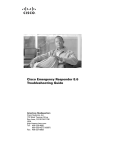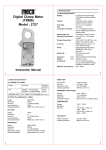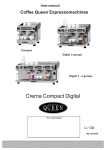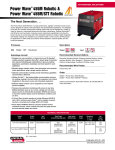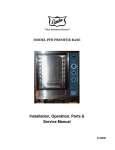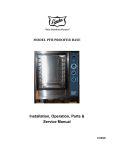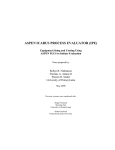Download Moffat 22 Instruction manual
Transcript
VERSATILE MOULDER Safe Operating Procedures TRAINING MANUAL Current 22 May 2003 Contains 24 pages V E R S AT I L E M O U L D E R CONTENTS • • • • • • • • • • • • • • • • About this Instruction Manual User Liability Safety Precautions Before You Start Name of Parts Hazard Risk Analysis Safe Operating Procedures Standard Operations Checklist Operations Checklist Operations Overview Product Guide Daily Cleaning Procedure Operations Competency Cleaning Competency Trouble Shooting Risk Assessment Moffat's policy is one of continual improvement and development. We therefore reserve the right to amend the information given in this booklet without prior notice. All sales will be subject to the company's conditions of sale. © M O F F A T 2 0 0 3 © M O F F AT 2 2 M AY 2 0 0 3 1 V E R S AT I L E M O U L D E R About this Instruction Manual This manual contains all the necessary information for the use, cleaning and maintenance of the machine. The purpose of this booklet is to allow the user to take all measures and set up all the human and material resources needed for safe and long-lasting use of the machine. This manual should be available for all staff and maintenance personnel authorised to use the machine. Do not attempt to use this machine in any other way that is not in compliance with the instructions supplied. Firstly Please read the instruction book carefully and follow the directions given. Secondly If you are unsure of any aspect of the instructions or performance of this equipment, contact your dealer immediately. The electric power supply The bakery must be fitted with an electrical system complying with current electrical regulations, in particular the earth connection system and electrical control board must be protected against overload currents and short circuiting. The rated power of the machine is shown on the machine plate. Electrical plant must be properly installed throughout the workplace, maintained and regularly inspected by qualified electricians issuing certificates of compliance for all jobs carried out, guaranteeing compliance with current Australian legislation and Standards. © M O F F AT 2 2 M AY 2 0 0 3 2 V E R S AT I L E M O U L D E R User Liability Working Safety The machine must be used only by personnel suitably trained for the purpose and who have been trained in the contents of this publication. To ensure safe work, comply with the following instructions: • Install the machine in compliance with workplace safe work requirements. • Install the machine in an area away from personnel not authorised to operate it and especially out of the reach of minors. • Continually reinforce safe workplace practices as outlined in this manual. • Eliminate all sources of distraction for the operator. • Do not wear loose fitting clothing or clothing with wide and open sleeves. • Designate a safe work area around the machine. • Do not let bystanders enter the safe work area provided for the machine.. • Do not remove, cover or modify the identification plates placed on the machine body. • Only use the machine for what it is designed to do. • Do not use the machine as a working top and do not place any objects on it that are not required for normal working operations. • Do not use the machine with temporary electrical connections or non-insulated cables. • Regularly check the state of the power cable and the cable clamp on the machine body. If defective replace immediately by qualified personnel. • Stop the machine immediately there is defective or abnormal operation, if a breakage is suspected, or there are incorrect movements or unusual noises. • Before cleaning or carrying out maintenance, disconnect the machine from the electricity mains. • Use protective working gloves for cleaning and maintenance. • For all extraordinary maintenance consult the manufacturer or qualified, authorised personnel. • Do not aim high-pressure jets of water at the machine. • When sharp accessories are manipulated, use cut-resistant gloves. • Never insert hands or other objects into the product inlet or outlet. Summary safety notes for owners/operators of this machine Always operate within the capability limits of the machine. Always carry out constant, regular and diligent maintenance. Ensure the machine is used by a single trained person. Eliminate all sources of distraction for the operator. The manufacturer declines all direct and indirect liability deriving from: • • • • • Use by untrained personnel. Non-observance of the instructions contained in this booklet. Unauthorised modifications and/or repairs carried out on the machine. The use of accessories and parts that are not genuine. Exceptional events. © M O F F AT 2 2 M AY 2 0 0 3 3 V E R S AT I L E M O U L D E R Safety Precautions To ensure maximum safety and optimum performance from this machine it is essential that you or any other operator of the machine read and understand the contents of this manual before the machine is started. Pay particular attention to the SAFETY INSTRUCTIONS highlighted by these symbols. CAUTION Serious injury possible These safety alert symbols mean CAUTION, WARNING or STOP/DANGER - a personal safety instruction. Failure to comply with the instruction may result in personal injury or death. WARNING: ELECTRICITY CAN KILL Test and tag electrical cables to workplace safety standards. WARNING Electric shock STOP DANGER User instructions and precautions The manufacturer declines all responsibility for any injury to persons or animals or damage to objects resulting from the failure to observe any of the previous or following information and instructions on the use or maintenance of the machine: • Do not use the equipment for any purposes and / or loads different to those stated by the manufacturer; • Every day, check the safety devices and general state of the equipment; • Every day clean the equipment thoroughly; • Take all the necessary precautions and safety measures when loading, adjusting, changing parts or carrying out repair or maintenance work on the machine. Ensure the machine or any parts of it are not accidentally started up by other persons; • Do not tamper with the guards and safety devices on the machine; • Do not remove the guards and safety devices on the machine unless necessary for maintenance purposes without adopting the measures designed to reduce the risk to the minimum possible, as described fully and frequently in this manual; • Put back all the guards and safety devices as soon as the reason for their temporary removal no longer exists; • All operators must comply with applicable workplace safety procedures. Definitions According to this manual, the following definitions are used: 1. "Danger area" any area inside or near a machine which might be dangerous for a bystander. 2. "Bystander" any person entirely or partly situated in a danger area. 3. "Operator" the person or persons installing, running, adjusting, cleaning, repairing, transporting or performing maintenance work on a machine. © M O F F AT 2 2 M AY 2 0 0 3 4 V E R S AT I L E M O U L D E R Before you start the VERSATILE M O U L D E R Before starting, undertake a General Safety check • Area clean and free from obstructions, e.g. nothing placed on top of the machine such as a dough knife, etc. • Operator not wearing loose fitting clothing. WARNING: Make sure the machine is switched off during cleaning, maintenance and lubrication When using the machine, never place hands near working areas. Mechanical or electrical repairs must only be undertaken by qualified service technicians. Only one person may operate the machine at any time. Any bystanders must keep well away from the machine. The key safety and hygiene features are: 1 A readily accessable emergency stop button in the form of a red mushroom safety switch. 2 The Versatile Moulder is fitted with a patented Safety Mouth Assembly which permits safe operation of the machine. Under no circumstances should this safety system be modified or removed. The Safety Mouth Assembly has been designed to prevent the operator from placing fingers anywhere within the mouth of the machine or near the sheeting rollers. 3 There are Belt Guards covering the belts on either side of the machine. 4 The Curling Chain and Safety Mouth Assembly are easily removed for cleaning purposes. 5 There is an overload switch button located at the rear of the machine. 1 1 Emergency stop button. A red mushroom safety switch. Push in to stop the machine. Twist and pull out to reset. Use theEmergency Stop only in an emergency. 2 2 The Safety Mouth Assembly. 3 Safety Belt Guards cover the belts on either side of the machine. 3 Use Stop Button to stop the machine under normal conditions. © M O F F AT 2 2 M AY 2 0 0 3 5 V E R S AT I L E M O U L D E R Names of Parts Emergency Stop Specialty Tube for shell or laminated rolls Attachment Raise/Lower Handle Guide Width Adjustment Handle (Loaf Guides) Attachment Mounting Frame Belt Guards Start Button Stop Button Rear Belts Adjustment Handle Safety Mouth Assembly Counter Weight Roll Chutes Emergency Stop Button Stop Bar Sheeting Roller Adjustment Handle Splitter Handle Catchment Tray Front Panel Locking Knobs Fixed Castors Lockable Swivel Castors © M O F F AT 2 2 M AY 2 0 0 3 6 V E R S AT I L E M O U L D E R Hazard Risk Analysis Machine in use WARNING: Set up the machine on a flat even surface. 3 Electrical isolation switch should be fully accessible to the operator. 1.5 metres above the floor is a recommended height. 3 1 Cleaning of machine should only be carried out with a damp cloth. Buckets of water or a hose should not be used. 1 ✓ ✗ 2 Do not remove or tamper with Micro Key Switch on Safety Mouth Assembly. Do not over–ride the microswitch during cleaning. Microswitch on guard should never be removed or tampered with in any way. 5 DANGER: Stay clear of the back of the machine while it is operating. 6 To shift the Moulder unlock the two front Swivel Castors first. 6 4 Do not push fingers under the front of the machine towards the blades. NOTE: Service panels must not be removed while machine is operating. Cleaning of the machine must not take place while the machine is operating. 4 WARNING When moving Moulder always push low down on the machine. Never pull the Moulder by the top of the machine. 7 2 © M O F F AT 2 2 M AY 2 0 0 3 7 V E R S AT I L E M O U L D E R 1 Check that the machine is clear of all objects and that all switches are off. 4 Test red Emergency Stop Button operation by pushing the mushroom button in. (See below) 6 Mould dough according to work-place procedures. Keep fingers clear of the Mouth Guard. WARNING: The operator should never tamper with or make repairs to this machine. All maintenance other than approved cleaning operations to be carried out by trained technicians only. 4 6 2 Check or place the electrical cord in the appropriate socket and turn power on. 2 The machine must stop operating immediately. If not, do not use the machine; call supervisor and/or Moffat Service Agent. 5 Test the stop bar at the feeder mouth by restarting the machine and depressing the bar. 7 NEVER by-pass factory fitted microswitchs in an attempt to run the machine while front guard is off. Fully isolate machine from electric power source before cleaning. 7 5 3 Push green start button to operate the Versatile Moulder. 3 The machine must stop operating immediately. If not, do not use the machine; call supervisor and/or Moffat Service Agent. © M O F F AT 2 2 M AY 2 0 0 3 8 MOFFAT SUGGESTS— Use this form to train staff, copy and laminate for your workplace Safe Operating Procedures V E R S AT I L E M O U L D E R MOFFAT SUGGESTS— Use this form to train staff, copy and laminate for your workplace Standard Operations Checklist ✓ OPERATION INSTRUCTIONS Set sheeting, roller gap to required product setting. Option for sandwich breads using splitter. Set rear belt to required product setting. Lower the loaf Guide Width Attachment between the belts. Pull out catch tray. Engage the Splitter. Press Start Button. © M O F F AT 2 2 M AY 2 0 0 3 9 V E R S AT I L E M O U L D E R Standard Operations Checklist OPERATION INSTRUCTIONS MOFFAT SUGGESTS— Use this form to train staff, copy and laminate for your workplace ✓ Feed dough into the Safety Mouth Assembly. Follow recommended work–place procedures for the desired product. Observe action of dough pieces under curling chain. Dough should curl upwards and not deviate to the sides. Check finished product against work–place standards for shape, size and consistency. Repeat process. Press Stop Button. NOTE: Use Emergency Stop Button only in an emergency. Use Stop Button to stop the machine under normal conditions. Emergency only Stop © M O F F AT 2 2 M AY 2 0 0 3 10 V E R S AT I L E M O U L D E R Operations Checklist FRENCH STICK 300g — 450g 4 PIECE SANDWICH BREAD 680g 1 Set Sheeting Roller gap to required product setting. 1 Set Sheeting Roller gap to required product setting. 2 Set Rear Belt Adjuster to required product setting. 2 Set Rear Belt Adjuster to required product setting. Arrow indicates the correct setting for 650g dough pieces. 3 Do not lower Guide Width Attachment. 4 Do not engage 4 piece Splitter. 5 Pull out Catch Tray. 6 Press Start Button. 7 Place dough piece into Safety Mouth assembly. 8 Observe action of dough pieces under Curling Chain 9 Check moulded french stick loaves against work-place standards for size, shape and consistency. 10 Place onto fluted french stick trays and repeat process. 11 Press Stop Button when finished. 3 Lower the Guide Width Attachment into the machine. This will ensure that the dough is placed in the centre of the Sheeting Rollers. 4 Engage the 4 piece Splitter. This cuts the dough into 4 pieces. 5 Pull out Catch Tray. Pull out sufficiently for ease of handling. 6 Press Start Button. 7 Place dough piece into Safety Mouth assembly. 8 Observe action of dough pieces under Curling Chain NOTE: Sequence dough pieces correctly to avoid doubles. 9 Check moulded 4 pieced loaves against workplace standards for shape, size and consistency. 10 Cross pan loaves, place into bread tin and repeat process. 11 Press Stop Button when finished. © M O F F AT 2 2 M AY 2 0 0 3 11 V E R S AT I L E M O U L D E R Operations Checklist HI–TOP 450g — 680g VIENNA 450g — 680g TANK LOAF 450g — 680g HOT DOG/KNOT ROLLS 85g — 120g 1 Set Sheeting Roller gap to required product setting. 11 Press Stop Button when finished. 2 Set Rear Belt Adjuster to required product setting. Arrow indicates the correct setting for 680g dough pieces. 450g dough pieces 120g dough pieces 3 Lower the Guide Width Attachment into the machine. Set on central placement. 4 Do not Engage the 4 piece Splitter. 5 Pull out Catch Tray. Pull out sufficiently for ease of handling. 6 Press Start Button. 7 Place dough piece into Safety Mouth assembly. 8 Observe action of dough pieces under Curling Chain. NOTE: Sequence dough pieces correctly to avoid doubles. 9 Check moulded dough pieces against work-place standards for shape, size and consistency. 10 Place loaves into bread tins and repeat the process. © M O F F AT 2 2 M AY 2 0 0 3 12 V E R S AT I L E M O U L D E R Operations Overview 1 Set sheeting, roller gap to required product setting. 1 If splitter option is required: The Guide Width Attachment must be lowered into the machine. The Guide Width Attachment keeps the dough pieces centred during the moulding process. D Adjusting the width of the Guide Attachment to suit the type of product. D A Un–clip handle from the bracket which holds the Guide Width Attachment in the up position. A E Engage splitter. 2 Set rear belt to required product setting. E 2 B Guide Width Attachment locked in the up position. B F 4 piece cutter for sandwich breads pictured below. Note: At this stage of the operation. Use of the splitter option for sandwich breads is possible. See opposite C Lower the Guide Width Attachment between the Belts. C F © M O F F AT 2 2 M AY 2 0 0 3 13 V E R S AT I L E M O U L D E R Operations Overview 3 Pull out Catchment Tray. 6 3 11 Check finished product against work–place standards for shape, size and consistency. 11 4 Press Start Button. 4 7 For rolls, feed dough pieces into Roll Chutes. 7 12 Repeat the process. 13 Press Stop Button when finished. 5 Place dough onto the Safety Mouth Assembly. Swing down to feed the dough into the moulder. 8 Making Paninni or Shell Rolls. 5 8 NOTE: Use the Emergency Stop only in an emergency. Stop Button to stop the machine under normal conditions. 6 For small dough pieces and rolls: Lock the Mouth Assembly by engaging the pin. 9 Follow recommended workplace procedures for the desired product. Stop Emergency only 10 Observe action of dough pieces under curling chain. All dough should curl upwards. © M O F F AT 2 2 M AY 2 0 0 3 14 V E R S AT I L E M O U L D E R Product Guide SHEETING ROLLER ADJUSTMENT REAR BELT ADJUSTMENT GUIDE WIDTH ADJUSTMENT 4-6 8 — LONG ROLLS 4 4 or 5 — SHORT ROLLS 6 6 — 60 GRAM SHELL ROLLS 4 4 — SECOND ROLLING 4-5 26 — 450 G SLIPPER VIENNA 6-7 ON ARROW — 450 G TRAYED VIENNA 6-7 13 — 680 GRAM SANDWICH 8 ON ARROW 4 PIECED SANDWICH ENGAGE 4 PIECE SPLITTER PRODUCT 450 GRAM. FRENCH STICKS 900 GRAM SANDWICH 10-11 ON ARROW © M O F F AT 2 2 M AY 2 0 0 3 15 V E R S AT I L E M O U L D E R MOFFAT SUGGESTS— Use this form to train staff, copy and laminate for your workplace Daily Cleaning Procedure WARNING Electrically isolate Dough Moulder. 1 Brush off all external surfaces. Use a bannister brush and work from top to bottom. Use bannister brush outside of machine; clean mouth assembly with damp cloth. 3 Open sheeting rollers to maximum (15) and wipe down with damp cloth. 3 1 4 To remove curling chain, undo Locking Knob and lift out the Chain Assembly. WARNING When moving Moulder always push low down on the machine. Never pull the Moulder by the top of the machine. 1 2 Take off cover by removing front panel Locking Knobs. 2 4 5 Unhook curling chain, check for build-up and wash if needed in warm water. 5 © M O F F AT 2 2 M AY 2 0 0 3 16 V E R S AT I L E M O U L D E R Daily Cleaning Procedure 9 Reassemble machine, turn on power and check for correct operation. MOFFAT SUGGESTS— Use this form to train staff, copy and laminate for your workplace 6 Inspect the curling chain before re-assembly. 6 7 Check rear belts for signs of old dough. Clean with plastic scraper if necessary and brush lightly. Note: Never use a metal scraper. 7 8 Clean attachment arms and rollers with a plastic scraper and damp cloth. 8 © M O F F AT 2 2 M AY 2 0 0 3 17 V E R S AT I L E M O U L D E R GUIDE SHEETS for Staff Training Pages in the following section of this manual should be copied and used when training staff to operate the VERSATILE M O U L D E R MOFFAT recommends that competency assessment check lists be completed signed and a copy kept in the personnel files for future reference. SUPERVISORS TO ENSURE • competency check lists are copied and completed as part of the training of staff • correct training of staff to the required competency expectations • sign off the verification section of the competency check list • place a copy of the completed and signed competency check list in personnel records as evidence of operator competence © M O F F AT 2 2 M AY 2 0 0 3 18 V E R S AT I L E M O U L D E R Operations Competency Checklist MOFFAT SUGGESTS— Use this form to train staff, and place a copy in personnel file. Element ✓ Implement safe work procedures. Assessment Criteria “Can the operator” Identify the purpose and use of: • Equipment guards • Warning signs • Safety features Related to this machinery? Identify: • Machine related health and safety risks of this equipment? • Emergency procedures to be used with this equipment? Operate this equipment correctly in normal and emergency situations? Identify: • OH&S reporting procedures related to hazard reporting for this machine? Comments To gain competency in the use of the VERSATILE MOULDER, the assessor must be satisfied that the operator has consistently applied the knowledge and skills in all of the above elements. This form should be signed off only when the assessor is satisfied that the employee/trainee is competent to carry out all of the tasks described above. Applicant’s signature Date / / Assessor’s signature Date / / © M O F F AT 2 2 M AY 2 0 0 3 19 V E R S AT I L E M O U L D E R Cleaning Competency Checklist ✓ Implement essential hygiene and sanitation procedures. MOFFAT SUGGESTS— Use this form to train staff, and place a copy in personnel file. Element Assessment Criteria “Can the operator” Maintain sound personal hygiene at all times when working with the VERSATILE MOULDER? Use appropriate protective and work clothing while working with the VERSATILE MOULDER? Identify: • Product handling requirements during production process? • Critical points in the process where contamination can be introduced? • Why it is important to monitor hygiene and sanitation performance? • The effect of poorly maintained equipment on the control of contamination and spoilage? • Company policies and procedures regarding hygiene and sanitation? • Actual and potential contamination and spoilage hazards? • Solutions to rectify contamination and spoilage problems? Use work practices and methods that reduce the risk of product contamination? Remove contamination where appropriate in accordance with: • Workplace hygiene and sanitation procedures? • Procedures specific to the VERSATILE MOULDER? Comments To gain competency in the use of the VERSATILE MOULDER, the assessor must be satisfied that the operator has consistently applied the knowledge and skills in all of the above elements. This form should be signed off only when the assessor is satisfied that the employee/trainee is competent to carry out all of the tasks described above. Applicant’s signature Date / / Assessor’s signature Date / / © M O F F AT 2 2 M AY 2 0 0 3 20 V E R S AT I L E M O U L D E R Trouble Shooting Problem The VERSATILE MOULDER does not operate/start. Remedy Possible cause Not plugged in to socket at main switch. Plug in and switch on. The main switch is “off”. Turn on. Fuse overload at the power board Contact supervisor. The moulder overload has been activated. Resets automatically (10 min). Stop button still locked in down position. Release by rotating and pulling. Start Button not pressed. Press Start Button. The moulder overload has been activated. Resets automatically (10 min). If overload occurs repeatedly contact supervisor/Moffat Service Agent. Fuse overload at the power board. Contact supervisor advise Moffat Service Agent. Dough too stiff/tight. Review and adjust rear belt settings to a wider gap. Mechanical malfunction. Loose belts or drive belts. Advise supervisor. Contact Moffat Service Agent. The VERSATILE MOULDER does not stop. Electrical/mechanical malfunction. Switch off power at main switch Isolate moulder by removing wall plug. Attach danger tag to machine. Contact supervisor advise Moffat Service Agent. The VERSATILE MOULDER belts operate in wrong direction. Inserting the VERSATILE MOULDER electrical plug into non-compatible socket after cleaning. Consult authorised electrical service to rewire or change polarity. Relocating VERSATILE MOULDER in another location after maintenance. Return to correct location. Machine started in wrong direction causing chain to jump off sprockets. Contact supervisor advise Moffat Service Agent. The VERSATILE MOULDER starts and then stops. The VERSATILE MOULDER labours under load. Electric motor functions but belts do not turn. © M O F F AT 2 2 M AY 2 0 0 3 21 V E R S AT I L E M O U L D E R Trouble Shooting Problem Possible cause Remedy Skinning of dough pieces. Dough pieces not covered during resting. Cover dough pieces. A fine mist of water can be sprayed on the product prior to moulding. Dough sticking to belt. Excess water in dough formulation. Redo batch. Add flour externally on dough pieces. Dough piece tearing. Insufficient water in dough mix. Redo batch. Settings too tight. Loosen settings. Moulder not cleaned as per cleaning instructions. Thoroughly scrape and check between rollers, scrapers and splitter blades. Review cleaning instructions. Poor ingredient quality. Contact ingredient supplier. Poor personal/bakery hygiene. Review and reinforce correct procedures. Holes in dough piece. Sheeting roller gap too wide. Close roller gap. Air bubble in centre of bread sticks. Stick being moulded from round dough ball. Premould and prove dough pieces in 200mm long shape and place sideways into the Safety Mouth assembly. 4 piece not cutting. Dirty or blunt cutting blades. Clean or have sharpened. Dough pieces doubling up as they go under the Curling Chain. Wrong dough sequencing. Sequence dough correctly. Dough too tight. Add more water in mix cycle. Dough too dry. Cover Dough pieces during resting. Foreign matter found/seen in dough. © M O F F AT 2 2 M AY 2 0 0 3 22 V E R S AT I L E M O U L D E R Risk Assessment The following risk assessment covers the reasonably foreseeable hazards to health and safety arising from the VERSATILE MOULDER and from systems of work associated with this machine. Hazard identified Existing controls Consequences Likelihood Risk rating Catastrophic Major injuries Moderate injuries Minor injuries Insignificant injuries Almost certain Likely Possible Unlikely Rare Extreme risk High risk Moderate risk Low risk Cleaning the machine with buckets of water or hoses is extremely dangerous and may lead to electrocution. The machine must be cleaned with a damp cloth only. Clear warning guidelines on machine. Safe work practices included in training manual. Catastrophic Rare High risk Micro Key Switch on Safety Mouth Assembly should never be removed or tampered with otherwise machine could continue working and be unsafe. Safe work guidelines are detailed in this manual. Alterations to micro switches are service items only. Moderate injuries Rare Moderate risk Electrical isolation switch should be fully accessible to the operator. Recommend no more than 1.5 metres above the floor. Dependent on store electrical policy Catastrophic Rare High risk Service panels should not be removed while the machine is in operation. The machine must not be operated with any service access panel removed. Designed to be accessed by authorised service technicians only. Warning signs clearly evident. Major injuries Rare High risk Moderate injuries Unlikely Moderate risk Cleaning of machine Safe, correct cleaning should not take place while procedure detailed in it is in operation training manual. © M O F F AT 2 2 M AY 2 0 0 3 23 V E R S AT I L E M O U L D E R Risk Assessment The following risk assessment covers the reasonably foreseeable hazards to health and safety arising from the VERSATILE MOULDER and from systems of work associated with this machine. Hazard identified Friction burns from inserting hand between the Belts at top rear of machine. Existing controls Area inaccessible from the front operating position. Warnings in manual and warnings about sole operator use. Consequences Likelihood Risk rating Catastrophic Major injuries Moderate injuries Minor injuries Insignificant injuries Almost certain Likely Possible Unlikely Rare Extreme risk High risk Moderate risk Low risk Minor injuries Unlikely Low risk Moderate injuries Unlikely Moderate risk Recommended placement of machine is back against a wall. Machine is top heavy and may unbalance if wheels catch an obstruction on the floor while the machine is being moved. Safe work guidelines reinforce correct moving procedure for the Versatile Moulder. © M O F F AT 2 2 M AY 2 0 0 3 24

























